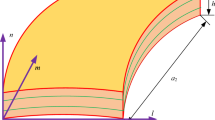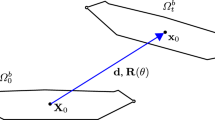Abstract
A quadratic eigenvalue problem (QEP) was posed in order to study the dynamics of flexible cylinders in cross-flow, simulating slender offshore structures such as risers, catenaries or tendons. The Euler–Bernoulli equation was used to model the structure assuming a fluid loading model, and yielding a quadratic eigenvalue problem that included a form of damping dependent not only on the structural damping itself, but also on the free stream velocity and the fluid force coefficients. We solved the QEP using the finite element method. We also derived a simplified analytical solution in this work for comparison with the QEP, however this solution does not consider changes in tension along the length of the cylinder as the QEP does. In our study, the QEP solutions were first validated against the simplified analytical solution, and also against a well-known experimental dataset obtained in 2003, in which a flexible circular cylinder model was used to model the dynamics of a riser undergoing multi-mode vortex-induced vibrations.





Similar content being viewed by others
References
Bearman PW (1984) Vortex shedding from oscillating bluff bodies. Annu Rev Fluid Mech 16:195–222
Bearman PW (2011) Circular cylinder wakes and vortex-induced vibrations. J Fluids Struct. doi:10.1016/j.jfluidstructs.2011.03.021
Sarpkaya T (1979) Vortex-induced oscillations, a selective review. J Appl Mech 46:241–258
Sarpkaya T (2004) A critical review of the intrinsic nature of vortex-induced vibrations. J Fluids Struct 19:389–447
Williamson C, Govardhan R (2004) Vortex-induced vibrations. Annu Rev Fluid Mech 36:413–455
Vandiver JK (1998) Research challenges in the vortex-induced vibration prediction of marine risers. In: 1998 Offshore Technology Conference, OTC 8698, Houston, TX
Bourguet R, Karniadakis GE, Triantafyllou MS (2011) Lock-in of the vortex-induced vibrations of a long tensioned beam in shear flow original research article. J Fluids Struct. doi:10.1016/j.jfluidstructs.2011.03.008
Evangelinos C, Lucor D, Karniadakis GE (2000) Dns-derived force distribution on flexible cylinders subject to vortex-induced vibration. J Fluids Struct 14:429–440
Lucor D, Mukundan H, Triantafyllou M (2006) Riser modal identification in cfd and full-scale experiments. J Fluids Struct 22(6–7):905–917
Meneghini JR, Saltara F, Fregonesi RA, Yamamoto CT, Casaprima E, Ferrari JA (2004) Numerical simulations of viv on long flexible cylinders immersed in complex flow fields. Eur J Mech B Fluids 23:51–63
Srinil N (2011) Analysis and prediction of vortex-induced vibrations of variable-tension vertical risers in linearly sheared currents. Appl Ocean Res 33(1):41–53
Willden RHJ, Graham JMR (2004) Multi-modal vortex-induced vibrations of a vertical riser pipe subject to a uniform current profile. Eur J Mech B Fluids 23:209–218
Chaplin JR, Bearman PW, Huera-Huarte FJ, Pattenden R (2005) Laboratory measurements of vortex-induced vibrations of a vertical tension riser in a stepped current. J Fluids Struct 21(1):3–24
Lie H, Kaasen KE (2006) Modal analysis of measures from a large scale viv model test of a riser in linearly sheared flow. J Fluids Struct 22:557–575
Trim AD, Braaten H, Lie H, Tognarelli MA (2005) Experimental investigation of vortex-induced vibrations of long marine risers. J Fluids Struct 21(3):335–361
Vandiver JK, Marcollo H (2003) High mode number viv experiments. In: Benaroya H, Wei T (eds) IUTAM symposium on integrated modeling of fully coupled fluid-structure interactions using analysis computations and experiments. Kluwer Academic Publishers, Dordrecht
Huera-Huarte FJ, Bearman PW, Chaplin JR (2006) On the force distribution along the axis of a flexible circular cylinder undergoing multi-mode vortex-induced vibrations. J Fluids Struct 22:897–903
Zhou Y, Wang ZJ, So RMC, Xu SJ, Jin W (2001) Free vibrations of two side-by-side cylinders in a cross-flow. J Fluid Mech 443:197–229
Reddy JN (2004) An introduction to the nonlinear finite element analysis, 2nd edn. Oxford University Press, New York
Tisseur F, Meerbergen K (2001) The quadratic eigenvalue problem. SIAM Rev 43(2):235–286
Huera-Huarte FJ (2006) Multi-mode vortex-induced vibrations of a flexible circular cylinder. PhD thesis, Imperial College London
Chaplin JR, Bearman PW, Cheng Y, Fontaine E, Graham JMR, Herfjord K, Huera-Huarte FJ, Isherwood M, Lambrakos K, Larsen CM, Meneghini JR, Moe G, Pattenden RJ, Triantafyllou MS, Willden RHJ (2005) Blind predictions of laboratory measurements of vortex-induced vibrations of a tension riser. J Fluids Struct 21(1):25–40
Bokaian A, Geoola F (1984) Wake-induced galloping of two interfering circular cylinders. J Fluid Mech 146:383–415
Assi GRS, Bearman PW, Meneghini JR (2010) On the wake-induced vibration of tandem circular cylinders: the vortex interaction excitation mechanism. J Fluid Mech 661:365–401
James M, Smith G, Whaley JWP (1994) Vibration of mechanical and structural systems with microcomputer applications. Harper Collins College Publishers, New York
Acknowledgments
The first author gratefully acknowledges the funding provided by the Ministerio de Ciencia e Innovación (MICINN) through grant DPI2009-07104. The second author gratefully acknowledges MICINN for the support provided through Grant TRA2010-16988. The authors wish to thank Dr. Juan Miguel Sánchez for the valuable discussions during the development of this work.
Author information
Authors and Affiliations
Corresponding author
Appendices
Appendix A: Details of the implementation using the finite element method
The flexible cylinder was idealized as a one-dimensional domain coinciding with the neutral axis of the structure. We used a mesh formed by one-dimensional elements \(\Upomega^e\) consisting of two nodes, \(\Upomega^e=[z^e_1,z^e_2], \) with the length of the element defined as h e = z e2 − z e1 , being z e1 and z e2 the global coordinates of the finite element at the first and the second node, respectively. The number of elements is n e = L/h e and the number of nodes results in n = n e + 1. We approximated the solution of Eq. 1 in each element with
where N is the number of degrees of freedom considered at each node of the element multiplied by the number of nodes of each element and ψ e j (z) are the shape functions. These can be written in a matrix form as follows:
with the displacement vector being \({\bf R^e}=[ u^e_1 u^e_2 v^e_1 v^e_2 | u^e_3 u^e_4 v^e_3 v^e_4]^T, \) including U e and V e. u 1 is the displacement at the first node (z e1 ), \(u_2=-\frac{\partial u}{\partial z}\) is the rotation in the first node, u 3 is the displacement at the second node (z e2 ) and \(u_4=-\frac{\partial u}{\partial z}\) is the rotation at the second node; the same applies to the components of V e. The P e matrices map the degrees of freedom with the corresponding displacements or rotations in the elemental displacement vector r e. The only non-zero elements in P e x are the ones occupying positions [1,1], [2,2], [6,6] and [7,7], and those are 1. In P e y , the non-zero elements are located at the [3,3], [4,4], [8,8] and [9,9] positions.
1.1 A.1 Weak form of the governing equations
A way to obtain the correct number of linearly independent equations when deriving the integral form of Eqs. 6 and 7 is to find its weak form [19]. We used a weight function to multiply the governing equations and, after integration by parts once in the second order term and twice in the fourth order term, the weak form of the differential equation was obtained. In the finite element method (FEM), the shape functions are used as the weight functions; therefore, by substituting the approximations in Eq. 12 into the governing Eq. 1, we obtained
with the secondary variables being
and
Doing the same for the y direction, we obtained
with the secondary variables being
and
The above equations may be compacted in matrix form
with K e, C e and M e as the elemental stiffness, damping and mass matrix, respectively. The stiffness matrix is
where \(\mathbf{K^e_x}=\mathbf{K^e_y}\) because EI and T(z) are the same in planes xz and yz. The stiffness matrix can be split into a bending and a tension matrix
and from Eqs. 15 and 20, the components of the matrices are
and
The damping matrix can be written as
with components
and
and finally the mass matrix is
with \(\mathbf{M^e_x}=\mathbf{M^e_y}\) and components
For computer implementation purposes, a change of variable yielding a local generic element \(\Upomega^R=[-1,1]\) was used. Integration of the equations was done using the Gauss-Legendre Quadrature formula.
Appendix B: Analytical solution of a simplified version of the problem
We sought to derive an analytical solution of a simplified version of Eqs. 6 and 7, where the damping matrix was diagonal and therefore the system was decoupled, so comparisons and an extra validation of the code for these simplified cases could be carried out. First, we dealt with the problem of a cylinder without tension applied on it (T = 0), and later on we introduced a constant tension along the length of the cylinder. The full problem with varying tension along the length of the cylinder and with the possibility of introducing a form of damping depending on C l was too complicated to be treated analytically, which is why we solved it numerically, as explained in the previous section. The results produced with the equations derived in this section appear together with the numerical results for comparison, in Tables 2, 4 and in Fig. 3.
1.1 B.1 No tension is applied to the cylinder
Consider the one-dimensional Euler–Bernoulli eigenvalue equation,
with the same boundary conditions as in 3,
where \(\widehat{A}\) is the generic deflection that can be \(\widehat{u}\) or \(\widehat{v}, \) and \(\overline{c}\) is a generic damping coefficient that can also be c xx or c yy depending on the direction considered. Looking for example to the x direction, in order to obtain a solution different to the trivial solution one (\(\widehat{u}=0\)), an eigenvalue condition must be satisfied. For the system in Eqs. 33–35 the condition is [25]
and the eigenvalues s that satisfy Eq. 36 are
For small values of n, pure real eigenvalues can be obtained in some situations. The imaginary part in Eq. 37 gives the natural pulsations of the system.
1.2 B.2 Constant tension is applied to the cylinder
Let us consider now a more complicated case, where the cylinder has a constant tension T. The equation becomes:
with the same boundary conditions as in Eq. 35. In this case an approximate eigenvalue equation can also be derived. We call σ n
and the eigenvalue equation is:
About this article
Cite this article
Huera-Huarte, F.J., González, L.M. Numerical prediction of the modal response of flexible cylinders in cross-flow with a current dependent form of damping. J Mar Sci Technol 18, 370–380 (2013). https://doi.org/10.1007/s00773-013-0214-5
Received:
Accepted:
Published:
Issue Date:
DOI: https://doi.org/10.1007/s00773-013-0214-5




